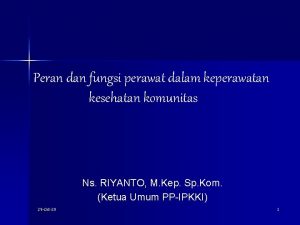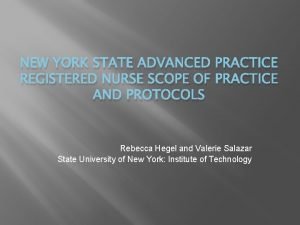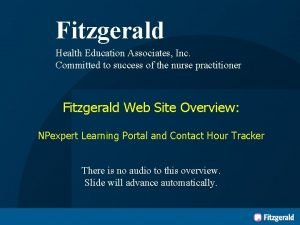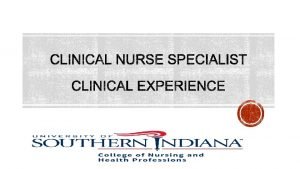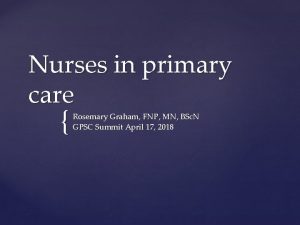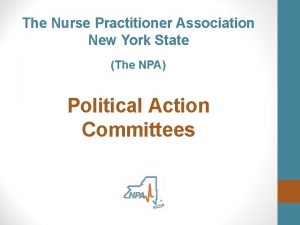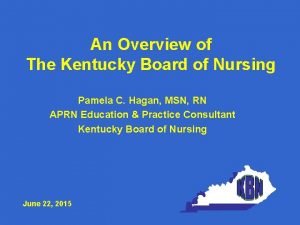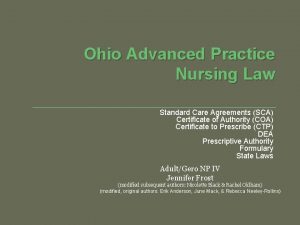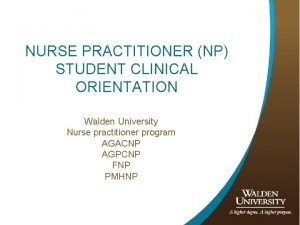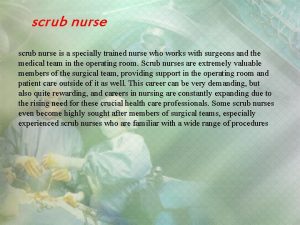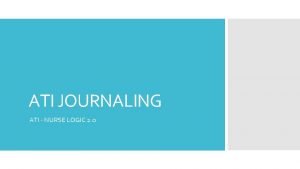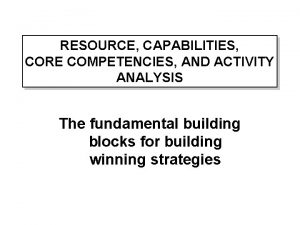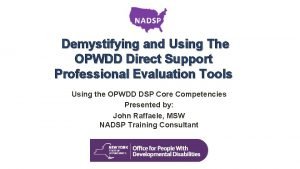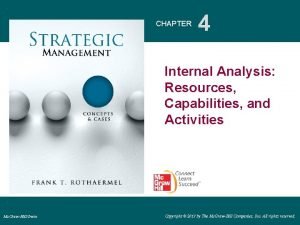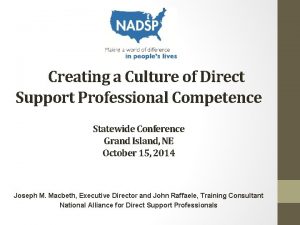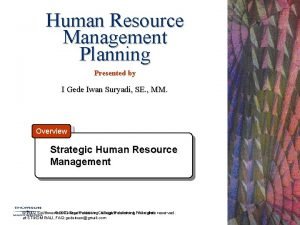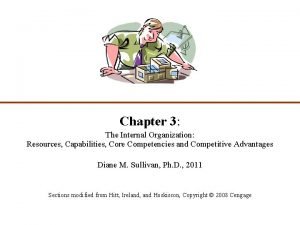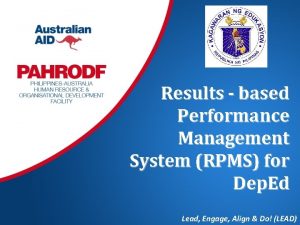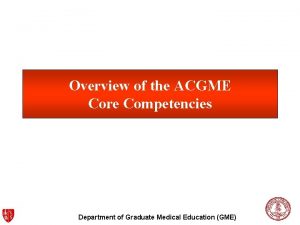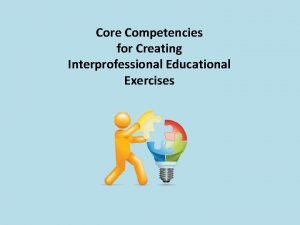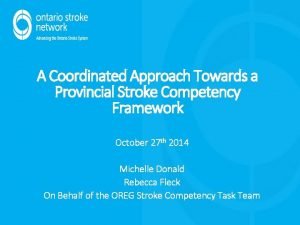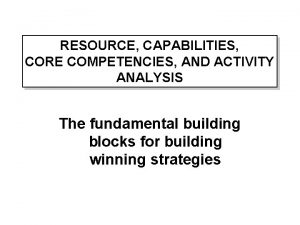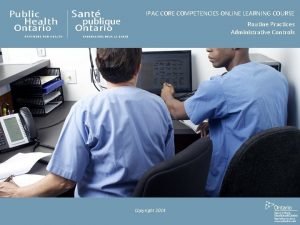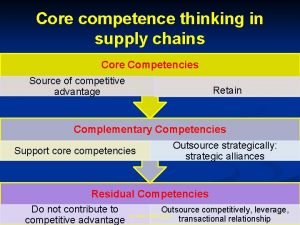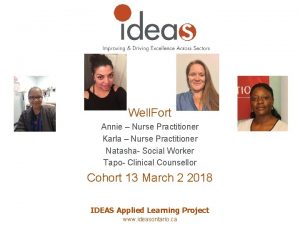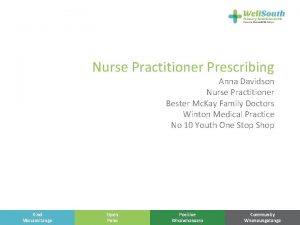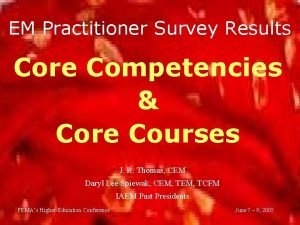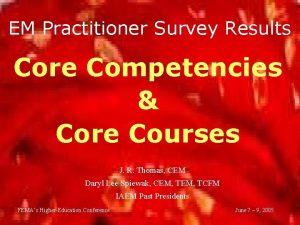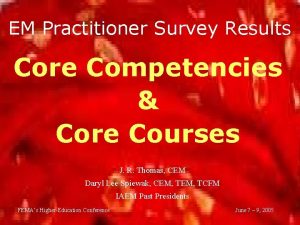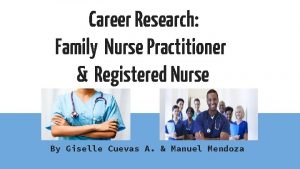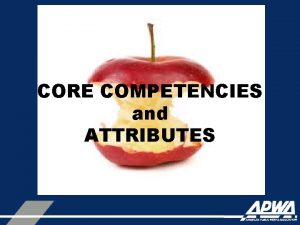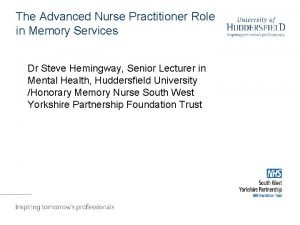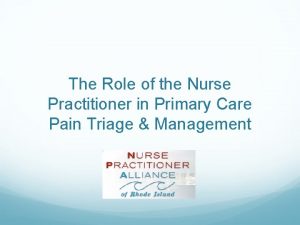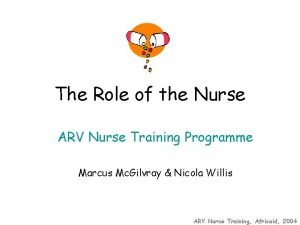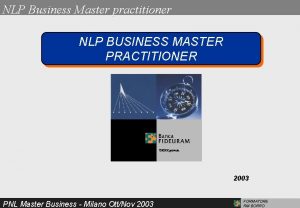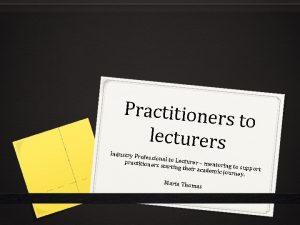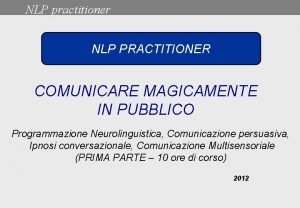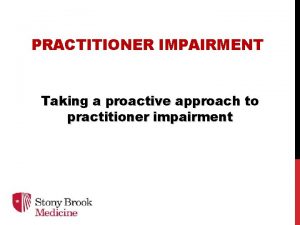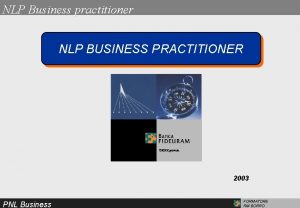Nurse Practitioner Core Competencies Population Role Competencies Suzanne











































- Slides: 43

Nurse Practitioner Core Competencies Population Role Competencies Suzanne August-Schwartz, DNP, APRN-BC, FNP

Nurse Practitioner Role Primary Care Providers ◦ Ambulatory care settings ◦ Long term care settings ◦ Provide nursing and medical services Individuals Families Groups/communities Educators and mentors Researchers Administrators

Education Entry level is Master’s degree Terminal degree is doctorate (DNP) Didactic and clinical courses Self-directed continued learning and professional development beyond formal education is essential to maintain clinical competency

Accountability Autonomy Certification Periodic peer review Clinical outcome evaluations A code for ethical practice Evidence of continuing professional development and maintenance of clinical skills Conducting research and applying findings to clinical practice

Responsibility Evolving role ◦ Societal change ◦ Health care needs Advancing the role ◦ Involvement in professional organizations ◦ Participation in health policy activities – local, state, national and international levels

Core Competencies Based on NONPF Competencies

Scientific Foundation 1. Critically analyzes data and evidence for improving advanced nursing practice. 2. Integrates knowledge from the humanities and sciences within the context of nursing science. 3. Translates research and other forms of knowledge to improve practice processes and outcomes. 4. Develops new practice approaches based on the integration of research, theory, and practice knowledge

Leadership 1. Assumes complex and advanced leadership roles to initiate and guide change. 2. Provides leadership to foster collaboration with multiple stakeholders (e. g. patients, community, integrated health care teams, and policy makers) to improve health care. . 3. Demonstrates leadership that uses critical and reflective thinking. 4. Advocates for improved access, quality and cost effective health care. 5. Advances practice through the development and implementation of innovations incorporating principles of change. 6. Communicates practice knowledge effectively both orally and in writing.

Quality 1. Uses best available evidence to continuously improve quality of clinical practice. 2. Evaluates the relationships among access, cost, quality, and safety and their influence on health care. 3. Evaluates how organizational structure, care processes, financing, marketing and policy decisions impact the quality of health care. 4. Applies skills in peer review to promote a culture of excellence. 5. Anticipates variations in practice and is proactive in implementing interventions to ensure quality.

Practice Inquiry 1. Provides leadership in the translation of new knowledge into practice. 2. Generates knowledge from clinical practice to improve practice and patient outcomes. 3. Applies clinical investigative skills to improve health outcomes. 4. Leads practice inquiry, individually or in partnership with others. 5. Disseminates evidence from inquiry to diverse audiences using multiple modalities.

Technology & Information Literacy 1. Integrates appropriate technologies for knowledge management to improve health care. 2. Translates technical and scientific health information appropriate for various users’ needs. 2 a). Assesses the patient’s and caregiver’s educational needs to provide effective, personalized health care. 2 b). Coaches the patient and caregiver for positive behavioral change. 3. Demonstrates information literacy skills in complex decision making. 4. Contributes to the design of clinical information systems that promote safe, quality and cost effective care. 5. Uses technology systems that capture data on variables for the evaluation of nursing care.

Policy 1. Demonstrates an understanding of the interdependence of policy and practice. 2. Advocates for ethical policies that promote access, equity, quality, and cost. 3. Analyzes ethical, legal, and social factors influencing policy development. 4. Contributes in the development of health policy. 5. Analyzes the implications of health policy across disciplines. 6. Evaluates the impact of globalization on health care policy development.

Health Delivery System 1. Applies knowledge of organizational practices and complex systems to improve health care delivery. 2. Effects health care change using broad based skills including negotiating, consensus-building, and partnering. 3. Minimizes risk to patients and providers at the individual and systems level. 4. Facilitates the development of health care systems that address the needs of culturally diverse populations, providers, and other stakeholders. 5. Evaluates the impact of health care delivery on patients, providers, other stakeholders, and the environment. 6. Analyzes organizational structure, functions and resources to improve the delivery of care.

Ethics 1. Integrates ethical principles in decision making. 2. Evaluates the ethical consequences of decisions. 3. Applies ethically sound solutions to complex issues related to individuals, populations and systems of care.

Independent Practice 1. Functions as a licensed independent practitioner. 2. Demonstrates the highest level of accountability for professional practice. 3. Practices independently managing previously diagnosed and undiagnosed patients. 3 a). Provides the full spectrum of health care services to include health promotion, disease prevention, health protection, anticipatory guidance, counseling, disease management, palliative, and end of life care. 3 b). Uses advanced health assessment skills to differentiate between normal, variations of normal and abnormal findings. 3 c). Employs screening and diagnostic strategies in the development of diagnoses. 3 d). Prescribes medications within scope of practice. 3 e). Manages the health/illness status of patients and families over time.

Independent Practice 4. Provides patient-centered care recognizing cultural diversity and the patient or designee as a full partner in decision-making. 4 a). Works to establish a relationship with the patient characterized by mutual respect, empathy, and collaboration. 4 b). Creates a climate of patient-centered care to include confidentiality, privacy, comfort, emotional support, mutual trust, and respect. 4 c). Incorporates the patient’s cultural and spiritual preferences, values, and beliefs into health care. 4 d). Preserves the patient’s control over decision making by negotiating a mutually acceptable plan of care.

Population Role Competencies Skills in which an entry-level, new graduate family nurse practitioner should demonstrate competence Family nurse practitioners demonstrate a commitment to family-centered care across the lifespan. Family nurse practitioners practice primarily in ambulatory care settings

Areas of Competence I. III. IV. V. VII. Health Promotion, health protection, disease prevention, and treatment. Nurse Practitioner-Patient relationship Teaching-Coaching function Professional Role Managing and negotiating health care delivery systems Monitoring and ensuring the quality of health care practice Cultural competence

Population: Family Unit Newborns Infants Children Adolescents Adults Pregnant and post-partum women Older adults

Focus of Care Family unit as it defines itself Individuals within a family or alone Commitment to family centered care Primarily in the ambulatory (outpatient) setting

I. Health Promotion and Disease Prevention Synthesizes theoretical, scientific and contemporary clinical knowledge for the assessment and management of both health and illness states Incorporate ◦ ◦ Health promotion Health protection Disease prevention Treatment focus of FNP practice

Assessment of Health Status Obtains and accurately documents a relevant health history for patients of all ages and in all phases of the individual and family life cycle. Assesses ◦ the influence of the family or psychosocial factors on patient illness, ◦ conditions related to developmental delays and learning disabilities in all ages, ◦ women's and men's reproductive health, including, but not limited to, sexual health, pregnancy, and postpartum care, and ◦ problems of substance abuse and violence.

Assessment of Health Status Performs and accurately documents complete or focused exam – including developmental and behavioral screening Screening evaluations for mental health Identifies health and psychosocial risk factors Demonstrates proficiency in family assessment Demonstrates proficiency in functional assessment of family members (e. g. , disabled, elderly)

Assessment of Health Status Assess specific family health needs within the context of community assessment. Identifies and plans interventions to promote health with families at risk. Assesses the impact of an acute and/or chronic illness or common injuries on the family as a whole. Distinguishes between normal and abnormal change with aging.

Diagnosis of Health Status Includes ◦ critical thinking ◦ differential diagnosis ◦ the integration and interpretation of various forms of data.

Plan of Care and Implementation of Treatment Objectives are to return the patient to a stable state and to optimize the patient's health The family nurse practitioner's role is to ◦ stabilize the patient ◦ minimize physical and psychological complications ◦ maximize the patient's health potential.

Plan of Care and Implementation of Treatment Provides health protection, health promotion, and disease prevention interventions/treatment strategies to improve or maintain optimum health for all family members. Treats common acute and chronic physical and mental illnesses and common injuries in people of all ages to minimize the development of complications, and promote function and quality of living.

Prescribing/Furnishing Prescribes medications with knowledge of altered Pharmacodynamics and pharmacokinetics with special populations such as infants and children, pregnant and lactating women, and older adults.

Special Skills Performs primary care procedures, including, but not limited to: ◦ ◦ ◦ ◦ suturing minor lesion removal lesion biopsy splinting, casting microscopy pap tests, coloposcopy joint injections sigmoidoscopy

Evaluation of Care Evaluates the effectiveness of the plan of care for the family, as well as the individual, and implements changes. Evaluates patient's and/or other caregiver's support systems and resources and collaborates with and supports the patient and caregivers.

Advocacy Assists families and individuals in the development of coping systems and lifestyle adaptations. Makes appropriate referrals to other health care professionals and community resources for individuals and families.

More Than a “Provider” Uses knowledge of family theories and development to individualize care provided to individuals and families. Facilitates transitions between health care settings to provide continuity of care for individuals and family members.

Individualized Care Assesses and promotes self-care in patients with disabilities. Recognizes the impact of individual and family life transitions, such as parenthood and retirement, on the health of family members.

Evidence Based Care Applies research that is family-centered and contributes to positive change in the health of and health care delivery to families.

II. Nurse Practitioner-Patient Relationship Personal, collegial and collaborative approach The competencies speak to the critical importance of interpersonal transactions as they relate to therapeutic patient outcomes. ◦ Maintains a partnership with individuals and families. ◦ Assists individuals and families with ethical issues in balancing differing needs, age-related transitions, illness, or health among family members. ◦ Facilitates family decision-making about health.

III. Teaching-Coaching Function Impart knowledge and associated psychomotor skills to patients by way of interpreting and individualizing therapies through the activities of advocacy, modeling, and tutoring.

Assessing Need Demonstrates knowledge and skill in addressing sensitive topics with family members such as sexuality, finances, mental health, terminal illness, and substance abuse. Elicits information about the family's and patient's goals, perceptions, and resources when considering health care choices.

Provides Guidance Assesses educational needs and teaches individuals and families accordingly. Provides anticipatory guidance, teaching, counseling, and education for self-care for the identified patient and family.

IV. Professional Role Demonstrate a commitment to the implementation, preservation, and evolution of the family nurse practitioner role. Family nurse practitioner implements critical thinking and builds collaborative, interdisciplinary relationships to provide optimal care to the patient.

Community Role Model Recognizes the importance of participating in community and professional organizations that influence the health of families and supports the role of the family nurse practitioner. Interprets the family nurse practitioner role in primary and specialty health care to other health care providers and the public. Serves as a resource in the design and development of family community-based health services.

V. Managing and Negotiating Health Care Delivery Systems Oversees and directs the delivery of clinical services within an integrated system of health care in order to achieve improved health outcomes for patients, families and communities Maintains current knowledge regarding state and federal regulations and programs for family health care.

VI. Monitoring and Ensuring the Quality of Health Care Practice Ensuring quality of care through consultation, collaboration, continuing education, certification, and evaluation Monitoring one's own practice as well as engaging in interdisciplinary peer and systems review.

VII. Cultural Competency Provides culturally competent care Delivers patient care with respect to cultural and spiritual beliefs Makes health care resources available to patients from diverse cultures.
 Fnp core competencies
Fnp core competencies Peran dan fungsi perawat
Peran dan fungsi perawat Air force reserve nurse practitioner
Air force reserve nurse practitioner Nysbon
Nysbon Fitzgerald health education
Fitzgerald health education Nurse practitioner norge
Nurse practitioner norge Usi nurse practitioner program
Usi nurse practitioner program New zealand nurse practitioner
New zealand nurse practitioner Crnbc renewal
Crnbc renewal Nys npa
Nys npa Kentucky nurse practice act
Kentucky nurse practice act Standard care agreement ohio
Standard care agreement ohio Walden university fnp
Walden university fnp Public health nurse competencies
Public health nurse competencies Scrub nurse role
Scrub nurse role A nurse preceptor is orienting
A nurse preceptor is orienting Process oriented learning competencies
Process oriented learning competencies Starbucks core competencies
Starbucks core competencies Strategic analysis techniques
Strategic analysis techniques Resources capabilities and core competencies
Resources capabilities and core competencies Opwdd core competencies
Opwdd core competencies Qsen competencies teamwork and collaboration
Qsen competencies teamwork and collaboration Core competencies of a company examples
Core competencies of a company examples Core competencies analysis
Core competencies analysis Core competencies meaning
Core competencies meaning Ibm business leadership model
Ibm business leadership model Nacada pillars
Nacada pillars Nadsp core competencies
Nadsp core competencies Hr core competencies
Hr core competencies Capabilities vs competencies
Capabilities vs competencies Business analyst skills matrix
Business analyst skills matrix Fbi core competencies
Fbi core competencies Rpms phase
Rpms phase Result-based performance management system
Result-based performance management system Acgme core competencies
Acgme core competencies Ipe core competencies
Ipe core competencies Disney swot analysis
Disney swot analysis Star stroke competencies
Star stroke competencies Myedhc
Myedhc Intel core competencies
Intel core competencies Netflix core competencies
Netflix core competencies Subway core competencies
Subway core competencies Ipac core competencies occupational health and safety
Ipac core competencies occupational health and safety Supply chain core competencies
Supply chain core competencies

